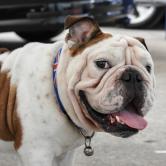What You Need to Know About Brachycephalic Syndrome in Bulldogs
Submitted by Petguide.com on August 29, 2017 - 1:41pm
You may not realize it, but the very thing that makes Bulldogs so unique is also the thing that causes them the most health problems. Bulldogs are one of several short-faced breeds that suffer from something known as brachycephalic syndrome. This syndrome cannot be cured but there are precautions you can take to keep your Bulldog safe and healthy.
What is Brachycephalic Syndrome?
The term “brachycephalic syndrome” refers not to a specific disease but to a group of conditions or abnormalities commonly seen in short-faced and flat-nosed breeds like the Bulldog, Boxer, Pekingese, Pug, and Shih Tzu.
The abnormalities included in this syndrome are stenotic nares, elongated soft palate, laryngeal saccules, and narrowing of the trachea. Stenotic nares are simply narrow nostrils and narrowing of the trachea occurs when the windpipe (the trachea) becomes smaller in diameter, restricting breathing. The soft palate is the tissue at the back of the throat – in some dogs it is too long and it blocks the airway to some degree. Laryngeal saccules are small pouches located in the larynx which can sometimes get sucked into the airway, restricting air flow.
What Can You Do to Care for Your Dog?
Your Bulldog may have one, several, or all of the abnormalities described above. If he does, he may exhibit certain symptoms like labored or noisy breathing, gagging, coughing, snorting, exercise intolerance, snoring, and difficulty swallowing. In cases where your dog’s airway is blocked he may suddenly collapse and he will have a very difficult time tolerating high temperatures. At the first sign of brachycephalic symptoms, you should have your dog checked out by a veterinarian. Your veterinarian will determine the severity of his condition and will tell you what your options are for treatment and management.
Because brachycephalic syndrome is not exactly a disease, it cannot be cured, per-say. However, there are certain surgical procedures which can help to correct or minimize the abnormalities that cause your Bulldog’s breathing problems. Stenotic nares can be widened and an elongated soft palate can be shortened. Laryngeal saccules can be removed as well. Keep in mind, however, that brachycephalic syndrome can sometimes lead to increased anesthesia risk, so talk to your veterinarian about the best option for treatment.
In addition to these surgical measures, helping your Bulldog maintain a healthy weight can greatly reduce the severity of his symptoms. You should also be careful about over-exercising your dog or exposing him to high temperatures. He needs to be kept indoors during the summer with air conditioning to control the temperature. If your Bulldog spends time outside, make sure he has access to shade and plenty of fresh water. If he starts to exhibit signs of breathing difficulty, take him back inside and make sure he cools down.
While it is easy to predict that your Bulldog might start having breathing problems during intense exercise or in the heat, but the symptoms of brachycephalic syndrome can sometimes manifest when you least expect them. Always keep a close eye on your Bulldog and watch for signs of this condition so you can promptly seek treatment, if needed.
Photo credit: Shutterdemon/Bigstock
~Petguide.com

